|
FORT LARNED
Commanding Officer's Quarters (HS-8) Historic Structure Report Historic Furnishing Study |

|
| HISTORIC STRUCTURE REPORT |
COMMANDING OFFICER'S QUARTERS DURING MILITARY OWNERSHIP
On October 22, 1859, in response to Indian hostilities and William Bent's exhortation to protect the Kansas portion of the Santa Fe Trail, Company K of the First Cavalry arrived on the Pawnee Fork and selected the first Fort Larned site. Originally called "Camp on Pawnee Fork," the name was changed on February 1, 1860, to "Camp Alert." By June of that same year, with the issuance of General Order No. 14, the post received its final designation in honor of Col. Benjamin Franklin Larned, the United States Army paymaster. [1] In the fall of 1860 the garrison's site was moved to a permanent location 3 miles west.
The original structures at Fort Larned were constructed with adobe. Company K evidently lived in tents or dugouts in the banks of the Pawnee Fork during the first winter. With the post's relocation, construction activity began. Adobe, however, proved an ill-suited material for building purposes, since weather conditions on the Kansas plains promoted rapid deterioration. The Civil War preempted funds and forced the state volunteer forces, who inhabited the post in that period, to make only minimal repairs.
When the regular army returned to Fort Larned in 1866, following the end of the Civil War, they found the post in an advanced state of disrepair. This stiuation prompted Maj. Cuvier Grover, the fort's commander, to sketch proposed building plans, which he submitted to Quartermaster General Montgomery Meigs in May 1866. Meigs refused to accept the plans because he considered them inadequate in detail and because no list of construction costs accompanied them. At approximately the same time, Maj. Gen. Winfield Hancock assigned a board of officers the task of selecting a new site for the fort. However, Gen. William T. Sherman, Commander of the Army, refused to approve another location. [2]
With General Sherman's decision not to move Fort Larned, plans went forward to build permanent structures. The proposed buildings included the commanding officer's quarters. Considering Q.M. Gen. Meigs's insistence on receiving detailed architectural drawings for approval before construction, elaborate plans were undoubtedly submitted to him. These drawings, however, have apparently been lost. The structure resembles a commanding officer's quarters plan which General Hancock approved on February 18, 1867, for general use in the Department of the Missouri (figure 1). It remains unclear, however, whether this drawing was modified by someone at Fort Larned, or if an architect at the department headquarters in Fort Leavenworth produced a set of drawings based upon the general plan. Adolph Hunnius, who was stationed at Fort Larned, made some of the architectural drawings for structures at the fort. He mentioned in his diary on August 26, 1867, that he had sketched a plan in lead print for the officers quarters to be used by the mason. Since construction on the commanding officer's quarters undoubtedly began before that date, Hunnius's drawing was intended only for the two other officers' quarters which were begun at a later time. Because Hunnius did not record that he had drawn the plan for the commanding offcier's quarters, it was probably compiled by some unknown individual. [3]

|
| 1. Ground Floor Plan of a Commanding Officer's Quarters Approved for General Use in the Department of the Missouri. |
By late June 1867 Capt. Almon F. Rockwell of the Quartermaster Corps arrived at Fort Larned to oversee the construction. Because of the lack of timber in the area, stone, obtained from nearby quarries and used in two previous buildings, was the selected building material. The commanding officer's quarters was probably the first structure on which work was begun in 1867. Rockwell chose to dress the stone for that building, but before its completion, Insp. Gen. Randolph B. Marcy visited the post and was appalled at the cost. Whether Rockwell intended to dress the stone for the other buildings remains unknown, but because of Marcy's visit, he discontinued this practice. [4] The other buildings were constructed with the cheaper undressed stone.
By October 20, 1867, the commanding officer's quarters was ready for the occupancy of Maj. Meredith Helm Kidd, the post commander. Maj. Marshall I. Ludington, of the Quartermaster Corps, inspected the post in October and reported, "A stone building 46x36 feet, with attic, kitchen 16x16 feet and cellar, for use of Comdg officer was advanced far enough in construction for shingling, and would be finished about the 20th inst." [5] On November 2, Bvt. Lt. Col. Albert Barnitz noted in his journal that the structure was completed. Five days later he wrote the same information to his wife. [6]
On April 21, 1868, Captain Rockwell filed a report on construction at Fort Larned that had been accomplished through January. It included the fol!owing list of materials and their cost for the commanding officer's quarters and the well. [7]
| Material | Dollars | Cents | |
| 712 | perches of stone | ||
| 757 | bushels of lime @ $1.10 | 832 | 70 |
| 4,299 | bushels of sand | ||
| 8 | bushels of hair @ 40¢ | 3 | 20 |
| 24,660 | feet of lumber @ $40.90 per M | 991 | 10 |
| 3,540 | feet of flooring @ $40.50 per M | 143 | 37 |
| 28,000 | shingles @ $7.50 per M | 210 | 00 |
| 14,200 | laths @ $4.00 per M | 56 | 80 |
| 6 | bbls plaster of paris @ $4.00 | 24 | 00 |
| 15 | locks @ 60¢ | 9 | 00 |
| 5 | boxes glass @ $5.15 | 25 | 75 |
| 4 | closet catchers @ 16¢ | 64 | |
| 56 | lbs putty @ 6-1/2¢ | 3 | 64 |
| 425 | lbs white lead @ 15¢ | 63 | 75 |
| 1/2 | gallon raw oil @ $1.83 | 92 | |
| 8 | gallons boiled oil @ $1.83 | 14 | 64 |
| 4 | gallons turpentine @ $1.50 | 6 | 00 |
| 6 | lbs Chrome yellow @ 20¢ | 1 | 20 |
| 1 | ream sand paper @ $4.20 | 4 | 20 |
| 2 | lbs glue @ 25¢ | 50 | |
| 1,780 | feet lumber @ $40.19 per M | 80 | 09 |
| 4 | doz. screws | 12 | |
| 2 | paper brads @ 16¢ | 32 | |
| 25 | lbs white lead @ 15¢ | 3 | 75 |
| 1 | gallon of oil @ $1.83 | 1 | 83 |
| 10 | kegs of nails @ $7.00 | 70 | 00 |
| TOTAL | 2,543 | 52 | |
Asst. Surg. W.H. Forwood described the quarter's interior. He stated that there were three officers' quarters, of which "one of these buildings is for the commanding officer; it contains a hall, four rooms, each 14 by 16 feet, a kitchen, 19 by 16 feet, and a servant's room over the kitchen, which is the only up-stairs room at the post" (figure 2). [8] The two rooms to the right of the hall were undoubtedly used as bedrooms, since the list of building materials included four closet catchers. The bedrooms must have each contained two closets similar to those shown in the sitting and family rooms of the general floor plan (figure 1). The parlor was immediately off the hall to the left. A column was placed on each side of the entry (figure 10). The dining room was next to the parlor, with a kitchen behind the dining room. A pantry and storeroom, shown between the kitchen and dining room in the general floor plan (figure 1), were absent in the Fort Larned quarters. This reduced the length of the quarter's rear space. Entrance to the upper-story room and cellar was gained by stairways in the kitchen. Although these stairways have since been remodeled, the originals were undoubtedly similar to those in the adjacent officers' quarters.

|
| 2. Original Floor Plan |
Interior walls were covered with plaster of paris which contained horsehair. Since the building materials list showed the use of chrome yellow, several rooms, probably the dining room and parlor, were painted with this color. The walls in the other rooms were undoubtedly painted with white lead or left unpainted. To eliminate the above speculation, however, an accurate appraisal of the original wall colors could perhaps be obtained by a diligent examination of the rooms. The "Ett" letter, written in 1878, depicted the rooms in one of the adjacent officer's quarters as each "of a different color." Since a number of paint colors were available, perhaps paint other than chrome yellow was used and not included on the materials list. (See the appendix for a list of paint and varnish used at Forts Larned, Hays, and Dodge in the period 1867-79.) Interior woodwork was no doubt the same as that described in the Ett letter for the adjacent officer's quarters. Ett wrote that "the wood work is all grained and varnished." [9] Additional evidence that the interior woodwork was grained can be found in the 1873 estimate for repair material. Copal varnish was one item on the list which was described as needed for use on the grained woodwork in the officers' quarters. [10]
On the exterior, as shown in four pictures (figures 3-6), the cornice, eaves, and rake were painted white, as well as the trim around the windows. The pictures complement Assistant Surgeon Forwood's observation when he wrote that "the facings of the buildings are painted white." The louvered window shutters were painted paris green, as evidenced in the 1873 repair materials estimate. [111] The earliest photograph (figure 3) reveals a white front door and trim, while pictures (figures 4-6) taken ca. 1876 and later, show a darker color paint. Perhaps the later paint was paris green. The front porch, including its ceiling, but not the balustrade and latticework at the base, was also white.

|
| 3. Commanding Officer's Quarters March 1875 (Daughters of the Army Collection), U.S. Army Military History Research Collection, Carlisle Barracks, Pensylvania). |
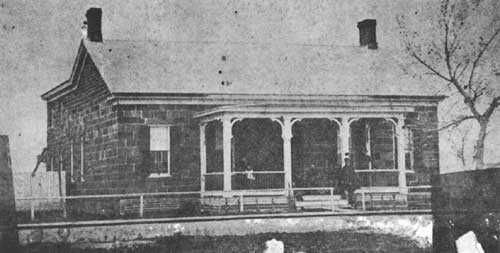
|
| 4. Commanding Officer's Quarters, ca. 1876. (Daughters of the Army Collection, U.S. Army Military History Research Collection, Carlisle Barracks, Pennsylvania.) |
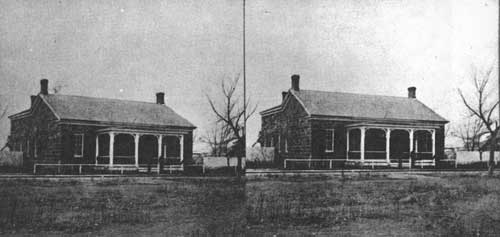
|
| 5. Commanding Officer's Quarters, ca. 1878-79 |
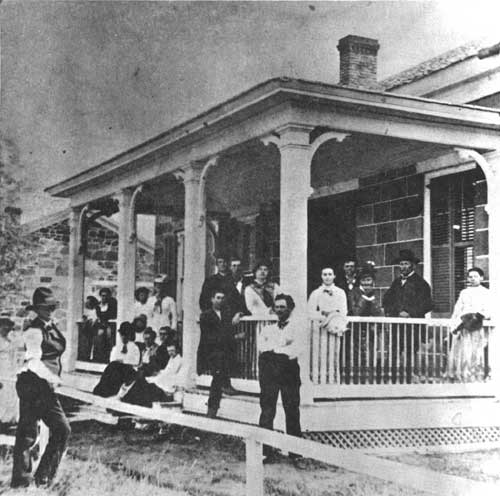
|
| 6. Commanding Officer's Quarters, ca. 1890s |
Photographs display a darker cast on the latticework and balustrade, which suggests that they were also paris green. In addition the ca. 1890s picture (figure 6) shows in excellent detail the front of the quarters, including the louvered shutters, balustrade, and latticework, as well as one chinmey. The rear porch had the same columns and brackets as the front one, as revealed in a mid-1920s photograph (figure 7). A second picture also shows in good detail a portion of the commanding officer's quarters rear porch (figure 8). The large fence which enclosed the rear yard was whitewashed. [12] A small white fence ran along the front of the dwelling on either side of the porch. A boardwalk was laid in the front of the quarters. Another fence composed of a single rail atop posts followed along the inside of the boardwalk.
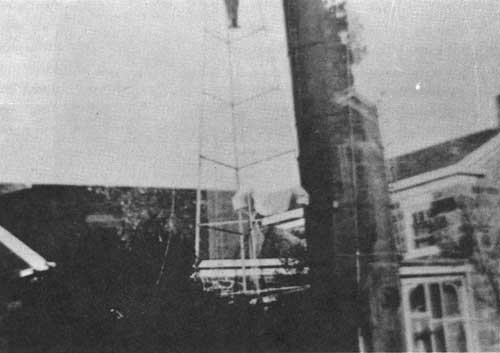
|
| 7. Rear of Commanding Officer's Quarters, mid-1920s |
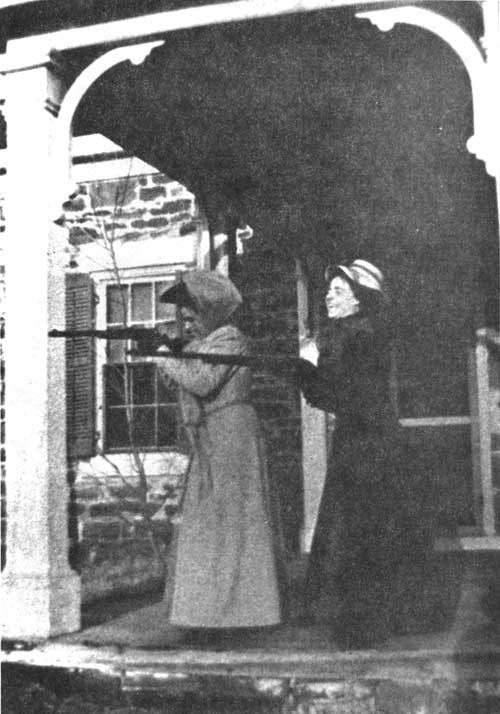
|
| 8. Rear of the Commanding Officer's Quarters |
The dwelling served as the commanding officer's quarters during Fort Larned's remaining active period (1867-78). As far as can be determined no structural changes occurred. The usefulness of Fort Larned ended by 1878 because Indian hostilities ceased on the Kansas plains in the early 1870s. In addition, the completion of railroads which followed the Smokey Hill and Sante Fe routes terminated the need to protect these trails. As a result Fort Larned was ordered discontinued by the secretary of war by General Order No. 4, dated May 9, 1878. As the last troops transferred to Fort Hays, a detachment, comprised of a sergeant and several privates, arrived from Fort Dodge to protect the abandoned property. [13]
On December 6, 1878, the secretary of war ordered the sale of the Larned buildings. Before any action could be taken, Maj. Gen. John Pope, the Department of the Missouri commander, reported that expected Indian troubles might "compel use of Post." [14] As a result of Pope's report, the secretary of war rescinded his order to sell the buildings. Although Gen. Phil Sheridan held a contrary view, Fort Larned remained in the army's care.
When 1st Lt. M.O. Payne arrived to inspect Fort Larned in September 1879, he noted that, among other damage at the post, portions of the fence around the officers' quarters had been removed. A part of the missing rail fence can be seen in figure 5. [15] Sgt. James Trophy, who reached Fort Larned in November 1880 to relieve the detachment there, reported that many windows and some doors were missing from buildings. He wrote that the people living in the area were very poor and implied that they probably had taken them. [16] Judging from the 1890s picture (figure 6), the commanding officer's quarters remained undisturbed.
Finally, on April 27, 1882, Congress passed an act to restore the Fort Larned land to the public domain. The transfer to the General Land Office was not forthcoming, for a study to convert the post into a normal and industrial school for Indian youths slowed the process. The Office of Indian Affairs, however, declined to accept the fort. In the meantime Fort Dodge was abandoned (October 2, 1882) and the army detachments were rotated from Camp Supply, Indian territory, to protect Fort Larned.
| <<< Previous | <<< Contents>>> | Next >>> |
hsr-hfs/hsr-sec1.htm
Last Updated: 18-Sep-2009